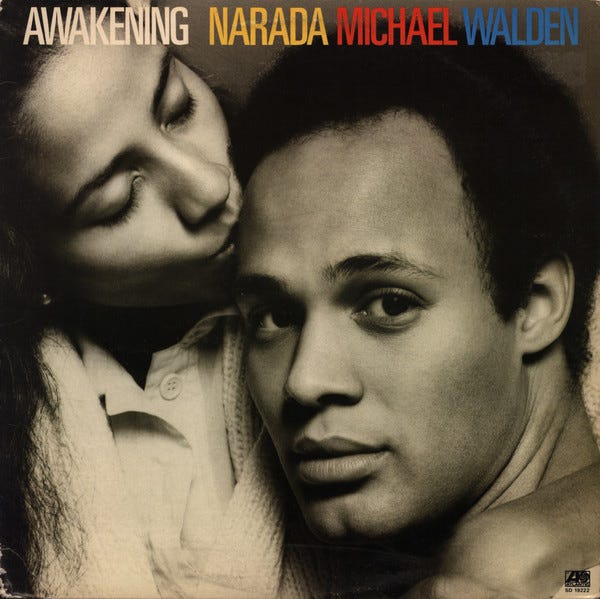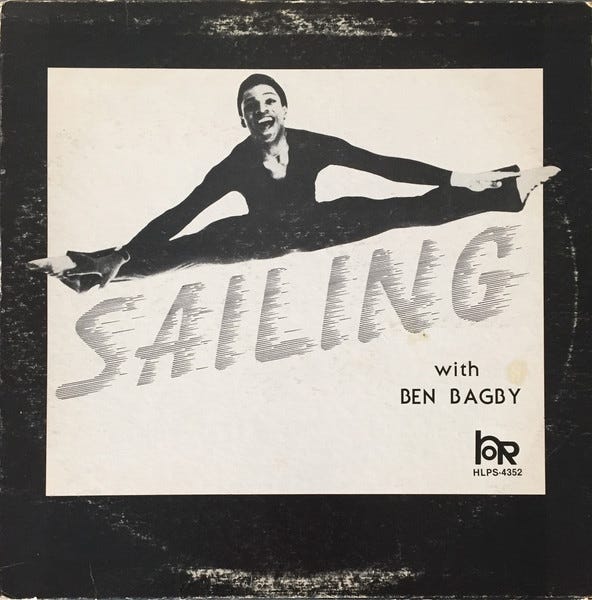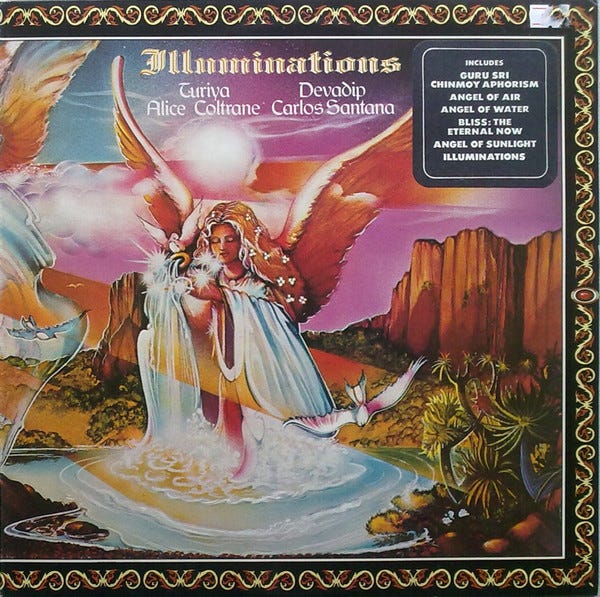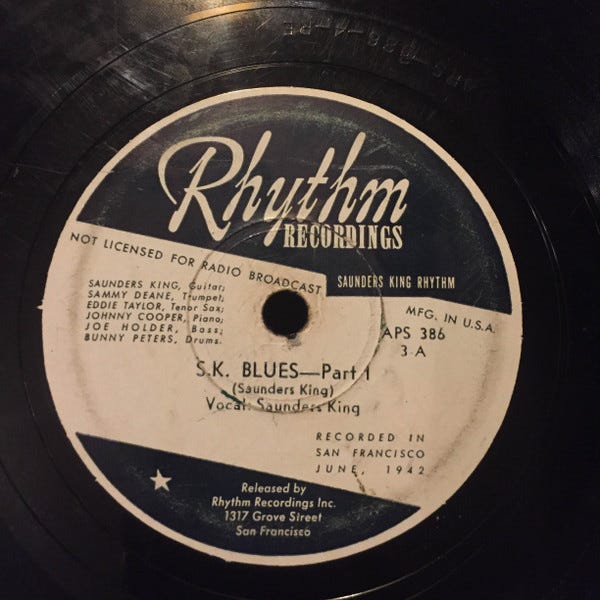I am free because I am not of the body.
I am free because I am not the body,
I am free because I am the soul-bird
That flies in Infinity-Sky.
I am the soul-child that dreams
On the Lap of the immortal King Supreme.
-Sri Chinmoy from The Soul-Bird
Living in New York in the early 1980s was ideal for finding used vinyl, and I spent a lot of time at Bleecker Bob’s in the Village. Here’s a 1978 picture of Bob outside his record store, by then located at 118 West Third Street just down from the Blue Note:
I probably picked up Oneness: Silver Dreams - Golden Reality at Bleecker Bob’s. That album has Guru’s Song, written by Sri Chinmoy, the Indian spiritual leader who taught meditation after moving to New York City in 1964. From the first time I heard Guru’s Song it remains one of my favorite Carlos Santana songs:
Just recently I noticed that the piano player on the track is Narada Michael Walden - “Narada” the Sanskrit name Chinmoy gave him. That took me instantly back to the early 1980s and Walden’s album Awakening:
It's an obscure album perhaps, but back then it was playing on New York City radio.
Before making a name for himself as a producer, Narada Michael Walden was a drummer for the Mahavishnu Orchestra’s second lineup, a position he took over in 1974 when Billy Cobham left to focus on his career. Walden recorded three albums with the Mahavishnu Orchestra, the last was Inner Worlds in 1976. Later in 1976, Walden signed with Atlantic Records. After his first two albums failed to chart, Atlantic gave him an ultimatum – if you don’t have a hit on your next album, we are going to drop you.
By the time Walden recorded his next album, dance music was at its peak in New York City. So Walden tapped into that scene with his 1979 dance floor-friendly Awakening.
When I first heard Walden’s music from that album I was going to school in New York. My girlfriend was a dancer in Manhattan and roomed with Ben Bagby, another dancer who appeared in dance numbers in the 1980 movie The Blues Brothers. Here’s Ben on the cover of a 1981 Danny Hoctor release, essentially a dance album used by choreographers and dance studio professionals - anyone dancing back then is familiar with them:
By the way, in early 1983 Bagby joined the first national tour of Dreamgirls – well, it was only a three-city tour: Los Angeles, San Francisco, and Chicago, but who’s counting? Later that year as a dance replacement, he joined the Broadway cast with Tommy Tune and Twiggy in My One and Only, which had a nice run from May 1, 1983, to March 3, 1985.
After Studio 54 re-opened, Ben, my girlfriend, and I would head over there from time to time. Give Your Love a Chance, Walden’s single from Awakening was popular among the Studio 54 DJs.
As it turned out, Awakening saved Walden’s career, and he went on to play on Rick James’ 1981 hit album Street Songs and make a name for himself as a record producer.
Another important song on Awakening is the title track:
When I bought Awakening I remember noticing the song’s guitar solo was by Devadip Carlos Santana and thinking, “Devadip, what’s that all about?”
Some years later I learned that by 1979, when Santana recorded this solo, he was already well into a creative and spiritual journey that began in the fall of 1972 when John McLaughlin introduced him to the teachings of Sri Chinmoy. In October 1972, like McLaughlin and Walden, Santana became a follower of Chinmoy, who gave him the Sanskrit name “Devadip” (meaning the eye, the lamp, the light of God). This was also the beginning of his spiritual awakening that resulted in three albums released under Devadip Carlos Santana: Illuminations (1974); Oneness: Silver Dreams - Golden Reality (1979); and Swing of Delight (1980). In his autobiography The Universal Tone, he refers to these three albums as his “most personal."
This week on that Big River called Jazz, we will explore the world of Devadip Carlos Santana.
In October of 1972, for the Columbia label Santana recorded Love, Devotion and Surrender, a duo album with John McLaughlin. When I listened to it for the first time, I realized this was not the Carlos Santana I knew from Black Magic Woman or Evil Ways. This was more in line with the Santana of Welcome, which was in my brother’s album collection and I’d been listening to for years. The album was a tribute to John Coltrane and includes interpretations of Coltrane’s A Love Supreme and Naima. Larry Young (under the Muslim name Khalid Yasin) plays stellar organ throughout. I’ve always liked the last song on the album, Meditations with McLaughlin on piano and Santana on acoustic guitar:
Another album at Bleecker Bob’s that caught my eye was Illuminations (there was “Devadip” again on the cover), which he recorded with Alice Coltrane:
Illuminations was recorded in 1974, while Santana was living at the Chinmoy's meditation center in Queens, New York. By this time he was deep into Eastern mysticism and re-evaluating where he was professionally and bringing it more in line with the new direction his personal life had taken.
Alice Coltrane, though not a follower of Chinmoy, was on a similar path and had taken the name Turiya (short for Turiyasangitananda, meaning "the highest song of God") hence on the album she is credited as Turiya Alice Coltrane.
From Illuminations, here is Tom Coster and Santana's composition Angel of Air/ Angel of Water :
Earlier this year, Burning Ambulance wrote a nice piece on Santana’s 1974 live album Lotus after 50 years. In it, he recalls a fascinating 2019 interview he had with Santana where he discusses this period:
I spent a whole week at [Alice Coltrane’s] house and we would wake up at 2:30 in the morning and meditate, and she would play the harp and then piano and the Wurlitzer organ. I learned so much by being around her, especially the way she was writing for this symphonic thing. For me, that album… being around Alice Coltrane and Jack DeJohnette and Dave Holland and Armando Peraza, it made me feel like I was in the minor leagues with Abraxas, and now I’m in the big leagues because I’m with these musicians who I felt were equipped to swim in the Pacific Ocean. I’ve said this before: There’s the Pacific Ocean, and the big lake, there’s the swimming pool, and there’s a bathtub. I was moving between the bathtub and the swimming pol until I started hanging around with them.
Interestingly and slightly off-topic, the great bassist Jimmy Bond plays on Illuminations. Twenty years earlier Bond joined Chet Baker’s Quartet shortly before Baker’s first European tour in September 1955. Along with Dick Twardzik, Bond also recorded on Chet Baker in Europe, released by Pacific Jazz in 1956.
I wrote about Twardzik here:
Illuminations also includes the great Cuban-Latin jazz percussionist Armando Paraza, who played with George Shearing, Cal Tjader, Harvey Mandel, and many others before joining Santana’s band in 1972. We should explore Armando Paraza a little further down the river...
Not surprisingly Devadip Santana’s new direction was a bit of a shock for his fans and the lack of their support showed. Illuminations was the first of nine Santana-related albums released in the U.S. to not go gold. Consequently, in 1974 Columbia released Santana’s Greatest Hits. It would take five years before Devadip Santana released his second record Oneness: Silver Dreams - Golden Reality, a mixed live/studio album released by Columbia in 1979:
I find this a real sleeper album that only gets better with time. It has the spiritually introspective Guru’s Song and Golden Dawn:
…and the more jazzy songs like Song for Devadip and Silver Dreams Golden Smiles with surprise vocals by Saunders King, the father of Santana’s wife Deborah King.
Saunders King was an American R&B and blues guitarist and singer from Louisiana. He moved to California as a kid and started playing guitar in 1938 when he was 19 years old. In 1942, he wrote and recorded the massive hit S.K. Blues for David Rosenbaum’s Rhythm Records. Rosenbaum owned and operated the Melrose Record Shop on Fillmore Street and Rhythm Records on Sutter Street in San Francisco, both meccas for lovers of jazz and black spirituals:
This is one of the earliest examples of electric blues guitar, the style T-Bone Walker would soon make famous:
Sandwiched between Santana’s more commercial rock albums Marathon (1979) and Zebop! (1981), Devadip’s third and final recording Swing of Delight was released by Columbia in 1980:
This release is significant because Devadip is joined by Miles Davis’ 1960s quintet members Wayne Shorter, Herbie Hancock, Ron Carter, and Tony William. Although it’s not one of my favorite Devadip Santana albums, I do like Santana’s composition Gardenia with Carter’s wonderful bass solo:
Here’s one more for the road. From Oneness: Silver Dreams - Golden Reality, here is I am Free, with Deborah King reciting part of Sri Chinmoy’s poem The Soul-Bird:
By 1981, Santana was disillusioned by Chinmoy’s clan and ended their relationship. In an article for Rolling Stone magazine, Santana shared that “this shit is not for me - I don’t care how enlightening it is.” He also shared that it still was “a good learning experience.”
Again from the 2019 Burning Ambulance interview, Santana reflected on this period:
Yeah, ‘73 was part of that… what some friends of mine call ‘career suicide.’ I’ve been accused of committing career suicide six or seven times, but for me it’s about learning. I want to stay that seven-year old child that’s thirsty for adventure, and sometimes it’s gonna go to radio and sometimes it’s not. But the main thing is to be true to what your heart wants to do.
That’s what I like about these three albums, which I call Devadip’s spiritual triumvirate. They were guided solely by his muse with little concern for selling records and pleasing record companies. That is their strength and from that strength comes their beauty.
Next week, on that Big River called Jazz, we’ll dig our paddles in and explore the world of another great guitarist Walter Trout.
Please hit this link to buy me a cup of coffee, if you’d like to show your guide some appreciation for this and past journeys. Know in advance that I thank you for your kindness and support.
If you like what you’ve been reading and hearing so far on our journey and would like to share this with someone you think might be interested in learning more about our great American art form: Jazz, just hit the “Share” button.
From Astaire to Sun Ra: A Jazz Journey is a reader-supported publication. If you feel inclined, subscribe to my journey by hitting the “Subscribe now” button.
Feel free to contact me at any time to talk shop. I welcome and encourage that.
Until then, keep on walking….













This is a very thoughtfully written and well-researched article, Tyler King. You captured a wonderful moment in the era of Jazz/Rock/Fusion that was seeing its most glorious years; the 70s decade. Your overview of a special time in New York with its music, dance, art, commingled with the end of the 60s fascination with Eastern philosophy, was strikingly on point. It was a uniquely magical time, especially in the Village. I lived above Kenny’s Castaways on Bleecker Street near Thompson during the last half of the 70s. To be a NYU student on my own with so many music venues steps away from my doorstep was thrilling. The Bottom Line, the Village Vanguard, the Bitter End ,and many others, was an education that no formal institution could ever provide.
Thank you, Tyler, for bringing to light once more a precious time in music. The albums you cited are extraordinary and filled with compelling musical artistry and composition. And oh, such awesome album cover art as a bonus!
Really lovely. Thank you.